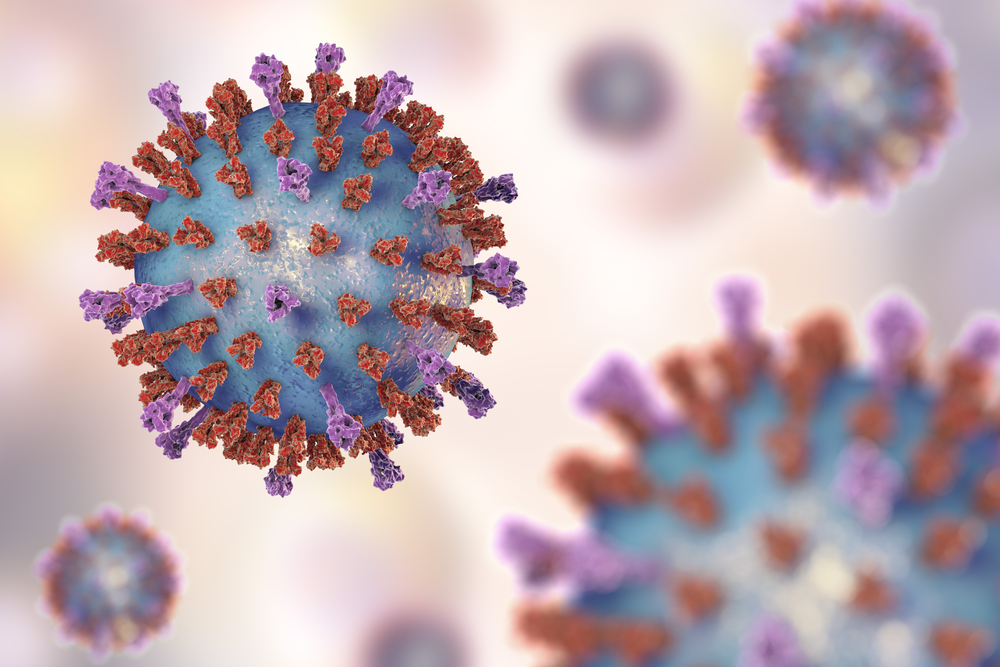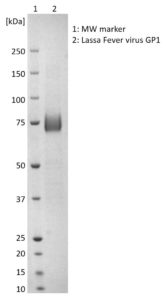SDS-PAGE: Coomassie-stained SDS-PAGE showing purified Lassa Fever Virus GP1.
Lassa Fever Virus GP1 Protein, Sheep Fc-Tag
Price range: $662.15 through $2,312.26 excl. VAT
Recombinant Lassa Fever Virus GP1 protein, comprising amino-acids 59-258 and incorporating a C-terminal sheep IgG Fc-tag, produced in mammalian HEK293 cells.
LASSA FEVER VIRUS GP1 PROTEIN
This Lassa Fever Virus GP1 Protein (Sheep Fc) is a recombinant protein expressed in HEK293 cells. The purified protein is designed for use in research and development of vaccines and immunodiagnostics for Lassa Fever.
PRODUCT DETAILS – LASSA FEVER VIRUS GP1 PROTEIN
- Recombinant Lassa Virus GP1. Sequence corresponds to AA59-258 of the glycoprotein precursor (NCBI P17332.1; strain GA391).
- Protein expressed in mammalian HEK293 cells with a C-terminal glycine-serine linker followed by a sheep IgG Fc-tag.
- Presented in Dulbecco’s phosphate buffered saline pH7.4, sterile filtered.
BACKGROUND
Though first described in the 1950s, the virus causing Lassa disease was not identified until 1969. The virus is a single-stranded RNA virus belonging to the virus family Arenaviridae. It is an enveloped virus with glycoprotein spikes on its surface. The Lassa Fever virus glycoprotein is synthesized as a 76-kDa glycosylated precursor protein (GP-C), which is posttranslationally cleaved into the N-terminal 44-kDa subunit Lassa Fever virus GP1 and the membrane bound 36-kDa subunit Lassa Fever virus GP2. GP1 interacts with the cellular receptor α-dystroglycan.
Lassa fever is a severe and sometimes fatal haemorrhagic disease caused by the Lassa fever virus (LAFV). First identified in 1969 in Nigeria, LAFV is an enveloped single stranded RNA virus that belongs to the genus mammarenavirus, of the Arenaviridae family of viruses. The natural reservoir for LAFV is the Mastomys natalensis rat, and transmission of LAFV to humans is through contact with contaminated rat urine and faeces. The virus is also spread from person-to-person via contact with contaminated human excreta, blood and bodily secretions, which causes a significant risk to health workers. LAFV is now endemic in West Africa and a significant outbreak of Lassa fever in 2016 resulted in 160 deaths.
Most individuals infected with LAFV remain asymptomatic but severe disease may occur in 15% of cases, with 1% of cases resulting in death. Symptoms of LAFV infection are variable, and non-specific, making early diagnosis difficult. The symptoms associated with Lassa fever range from mild fever, with headaches and fatigue, to severe life threatening multi organ failure. Early stages of the disease resemble symptoms of typhoid and malaria and therefore misdiagnosis is a risk (WHO).
REFERENCES
- Lassa Fever. World health Organisation (WHO). 31 July 2017.


